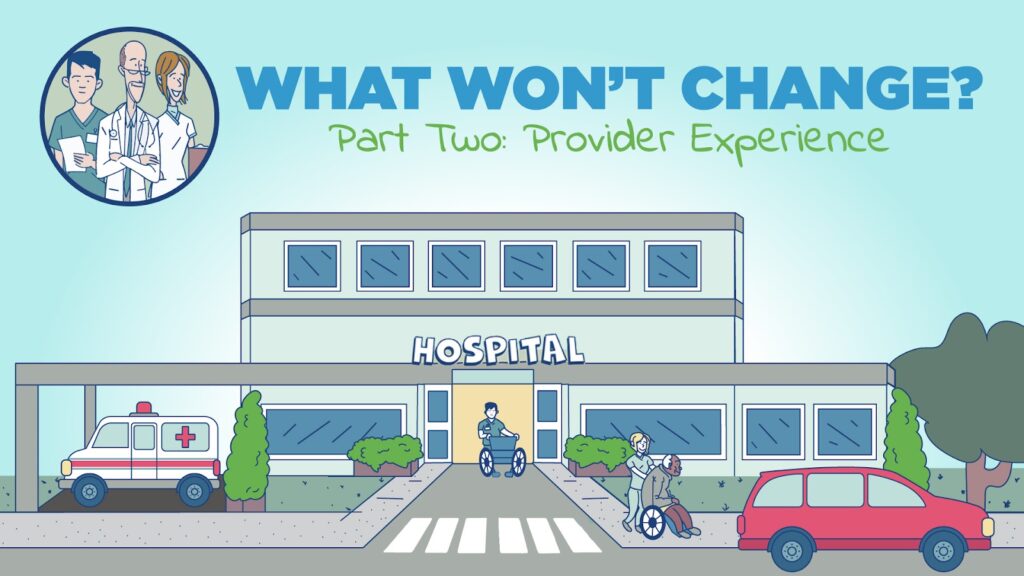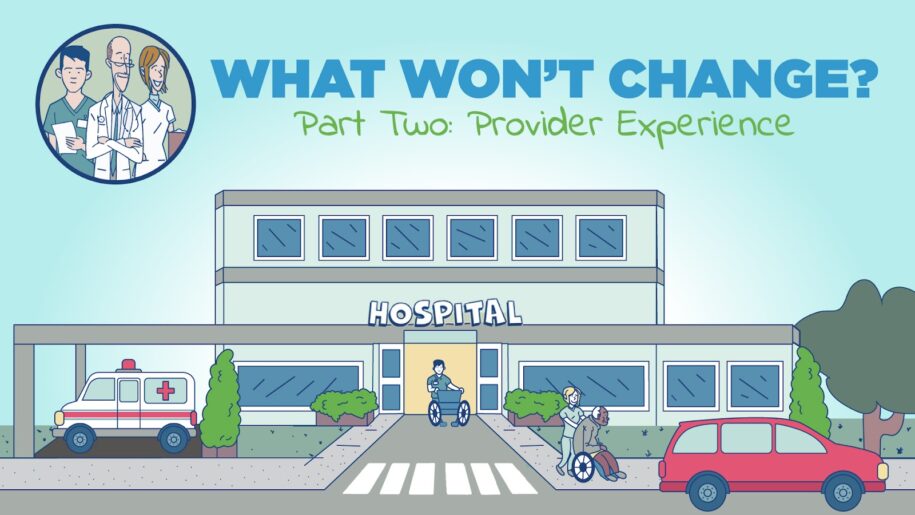
What Won’t Change? Part Two: Provider Experience
These elements of the provider experience aren’t likely to change in the next 10 years
This is the second of a three-part series called “What Won’t Change?” where we examine the mainstays in health care that are likely to stay the same over the next decade.
The mechanics of care delivery have not changed since the beginning of medicine. Even millennia ago, the first physicians in Greece knew about bedside manner. They knew they needed their patients’ trust if they hoped to be successful.
As we consider what parts of health care are likely to stay the same over the next decade, we know for certain that elements of the provider experience will remain firmly in place. After all, they’ve been that way quite literally for thousands of years.
1. Health care cannot be transactional, and good doctors will always fight to stop it from going that way
This is the fee-for-service vs. value conundrum. In this country, commerce is based on a value exchange in which it’s more convenient to ascribe value to codable transactions. It works in many cases of care, especially in the acute setting.
For instance:
• You break your arm and you want it to heal properly. You get an MRI and a hard cast; you pay the doctor for their care and you pay the hospital for its facilities.
• You pay the pharmacy for the painkillers and you pay the physical therapist to regain range of motion.
• You and your health insurance provider pay a few thousand dollars for you to get a desired outcome — a fully healed arm. That’s a value exchange.
But when it comes to chronic disease care — the costliest kind of care — the outcome we seek may be far more slippery. Patients are more likely to comply with medication and report new symptoms when they have a deep level of trust with their provider. Likewise, their provider is more likely to catch red flags and stage less dramatic interventions when they know their patients well and interact frequently.
Transactional health care is more often the default because it’s easier to apply across large patient populations. But good physicians will work hard to develop relationships that help their patients thrive.
2. Health care will always be a service industry
In the binary world of goods and services, health care aligns in with the latter. We can never box it up or trade it like orange juice futures. Health care is not a commodity, though at times it feels squeezed like one.
The enormous health care machine, all the research and technology, the supply chains, the institutions and workforce development, they exist to support singular interactions between providers and patients. Each time, the patient presents a puzzle — some are easier than others, but there’s always a puzzle — and the provider works to solve it using the tools and knowledge they have.
From that perspective, health care aligns more with the auto mechanic than the dealership. Over the next 10 years, there’s no chance that will change.
Even as more and more processes become automated through artificial intelligence, health care will still be a service industry in which people help other people.
3. One provider will never treat the whole patient
A super doctor will never exist. Delivering care will always require an x:1 ratio. It will always take professionals of varying skill levels and disciplines to treat a single patient.
The downsides are obvious: patients will always seek care from providers who may not be speaking to each other.
Managed care and electronic health records have smoothed out some of the bumps in these interactions, but consider a patient with complex comorbidities in a competitive market. They may choose to get cancer care from an oncologist in one health system, internal medicine from another and rehab from a third.
Now imagine 10,000 other patients in that market with similar, but not identical, cases. How do you ensure equity among the entire population?
There’s a tremendous focus today on whole-person health using teams to treat individual patients. That’s because we’ve figured out that coordinating specialties to care for one person is far more effective than doling out care from silos.
Chronic care management and remote patient monitoring are a linchpin in the whole-patient care movement. The Centers for Medicare and Medicaid Services agrees, too, based on the relative value unit multipliers updated for this year.

4. Healthcare will always be longitudinal
Care delivery can’t end at discharge, after an episode or an office visit. Patient lives are inherently longitudinal; they run on a continuum that never stops. So in order to protect their quality of life, care must run on a parallel track. Or, at the very least, people need to maintain an ongoing relationship with health care from cradle to grave.
Young, healthy people presumably won’t need much more than an annual checkup and perhaps some behavioral health and chiropractic.
The longitudinal nature of care grows more defined as people age and their health needs intertwine. This is where chronic care management becomes a powerful solution for maintaining that quality of life.
5. Providers will always struggle to balance access with sustainability
The pandemic magnified the struggle. Emergency departments turned away patients and operating rooms delayed procedures because they lacked the space and clinicians to meet those needs. If we look at health care as a resource, we realize how limited it is. This is where care starts to feel like a commodity.
Providers, and perhaps more specifically health system administrators, have their hands on the valve. They must balance which populations receive the right level of care to ensure their hospitals can do more than stay open — they want to grow and achieve even better outcomes.
Earlier, we bemoaned the health system administrators who lean toward treating care like a transactional value exchange rather than the intimate and very human exchange that happens between good doctors and patients who trust them.
But really, those executives are thinking about the most straightforward way to ensure their hospitals stay viable and grow.
Compelling research from 2015, published in BMC Health Services, found that outcomes for cardiovascular disease were far better in hospitals that have sound financial footing. In fact, of the studied hospitals, outcomes improved in the years following “an increase in hospital profitability, financial leverage, and labor costs.”
We can extrapolate that hospitals pursuing profits in the name of providing better care must engage in a complicated balancing act if they want to offer more access to excellent care to the greatest number of people.
What does it mean through the chronic care management lens?
When we look at provider experience mainstays, we quickly see how chronic care management slides in to lubricate all of them.
• A full-scale CCM program extends doctors’ reach and lets them offer care that feels less transactional and more relational.
• It adds a simple but critical touch point to the patient experience, one that extends a provider’s relationship with their patients outside the four walls of their offices to engage patients where they are — in their homes and daily life.
• CCM strengthens the care team network and opens communication between all providers.
• Because check-ins happen every month, the care closely follows the longitudinal demands of effective care.
• Finally, because it’s simple to incorporate at the individual level, we can deploy CCM across large patient populations. While we’ve found that health systems typically struggle to roll out CCM programs at scale on their own, a committed partner like Signallamp can tailor-fit its platforms and scale immediately.
Some of the truths of delivering health care have remained unchanged literally for thousands of years. At Signallamp Health, we empower providers and health systems to manage them with excellence. Schedule a consultation with us to find out how.

